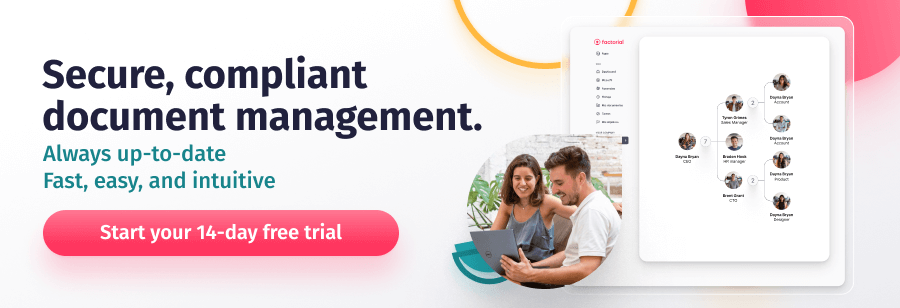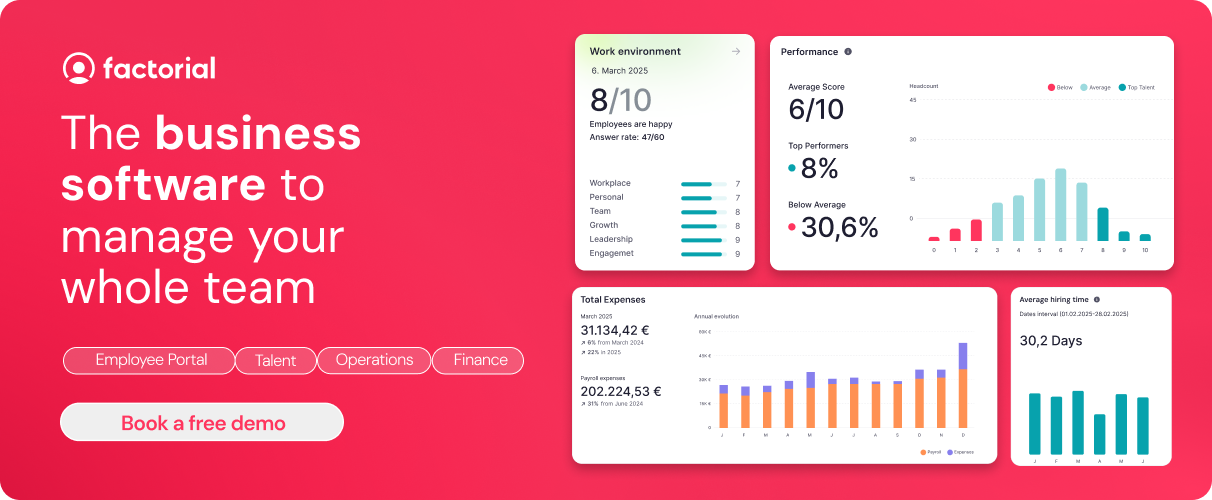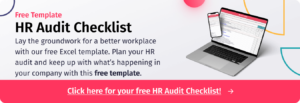Accurate recordkeeping, as well as secure filing, storage, and maintenance of employee files, is an essential practice for all employers. Aside from protecting the security of confidential data, it is also a legal obligation as defined by a number of employment laws. For example, the Equal Employment Opportunity Commission (EEOC) requires that employers keep all employment records for one year. If an employee is fired, their personnel records must be retained for one year from the date of termination.
- What Are Employee Files?
- Types of Employee Documents and Records
- Documents Required for Employee Files
- What Is Employee File Management?
- How to Organize Employee Personnel Files
- Managing Secure HR File Documentation
- HR Document Management Software ✅
In this guide, we will share an employee files checklist to help you maintain accurate records for all your employees. We will also discuss a few best practices for human resources file management to help you stay compliant.

What Are Employee Files?
An employee file, also known as an employee record or employment file checklist, is a paper or electronic folder made up of employee documents that detail the relationship between an employee and the company. Documents cover the entire employee lifecycle, from recruitment right through to termination or resignation. Employee files should also contain basic employee documents and compensation information in compliance with federal and state labor laws.
So, why are employee files so important, and how long do employers keep employee records?
For one thing, employee file forms can serve as evidence of an employee’s disciplinary history in the event of termination or dispute. Secondly, they help you to effectively monitor performance goals, attendance, and productivity levels. Finally, they serve as a written record of training development and requirements.
Aside from being a good business practice, certain employee records also need to be maintained in order to comply with specific provisions under both federal and state law. Laws such as the EEOC and the FLSA establish what information must or should be collected, what your company can do with that information, and how long you should store your employee records. Make sure you are aware of all requirements in your area.
Discover Business Management Software that helps your team do more.👇

Types of Employee Documents and Records
An employee file contains a range of documents spanning the entire employee lifecycle, from hiring right through to when an employee leaves your company. Some documents are required by law, others are just recommended.
Here are some of the standard documents usually contained in employee files.
Basic Information
This includes any personal data that you need access to as an employer. For example, full name, address, education and qualifications, and date of birth. It’s also a good idea to keep a record of an employee’s emergency contact numbers.
Hiring Documents
Most employers also keep a record of documents relating to the hiring process in an employee’s personal file. This usually includes job descriptions, employment applications, resumes, interview notes, and references.
It’s also a good idea to keep a record of any signed acknowledgments as a written record that an employee has understood all policies contained within your employee handbook. This will protect you against any potential disciplinary issues or disputes.
Employment-Related Agreements
Aside from the hiring documents mentioned above, you should also keep a record of all employment-related agreements in your employee files. This includes offer letters, employment agreements, confidentiality or non-disclosure agreements, union contracts, non-competition contracts, and non-solicitation agreements. You also need to keep a copy of any agreement relating to company cars or business credit cards.
Performance and Development
This might include any or all of the below. There is no legal obligation here so the records you maintain will depend on your company’s HR strategic plan and your annual HR plan.
- Copies of any performance evaluations or appraisals
- Employee self-assessments
- Any records of performance issues, together with corrective or disciplinary actions where relevant
- Performance improvement plans
- Employee recognitions such as certificates or awards
- Training records and development plans
- Copies of any internal or external complaints made about an employee
- Records of training or education
- Promotion or demotion records
It is especially important to keep a record of these documents if your company is going through a process of change management.
Payroll & Compensation
You should keep a written record of an employee’s salary and compensation package and update their personal file each time their salary is adjusted. You also need to maintain a record of all employee W-4s and beneficiary forms, payroll records, and timecards.
However, make sure documents don’t include confidential payroll data such as bank account details or social security numbers. You should keep these in a separate payroll file or database.
Termination and Post-Employment Information
If an employee is fired or hands in their notice, their personnel records must be retained for one year from the date of termination by law. You should also keep a record of any information relating to their termination to protect you in the event they raise a dispute.
This usually includes the following documents:
- Employee resignation or termination letter
- If terminated, reasons why you dismissed the employee
- Exit interview forms
- Cobra notification
- Final employee performance appraisals
- Unemployment compensation forms
- A copy of the employee’s final paycheck, including confirmation of vacation pay and the return of any company property.
Documents Required for Employee Files
As we have already seen, there are some employee documents that you must keep in your employee files by law and others that are advisable. It’s a good idea to regularly review the employee records you maintain whenever you are conducting an HR audit.
You must keep a copy of the following employee records by law. Make sure you include them in your HR compliance checklist:
- Basic employee information: Name, address, phone number, and emergency contact details
- IRS tax withholding forms: W-4s and/or W-9s
- Payroll and compensation data, as detailed above
- Contracts or agreements, as detailed above
- Employee benefits forms: medical enrollment forms and beneficiary agreements, retirement forms 401(k), FSA agreements, HSA agreements, etc.
- Child support documents, including any legal or litigation documents
- Workers’ compensation, including any filed claims
- Termination documents, as detailed above.
What Not to Include in Your Employee Files
Aside from the documents we have already looked at, there are other confidential documents that you should keep a record of. You must keep these documents separate from your standard employee files.
Include a review in your HR audit checklist to make sure the following confidential documents are not included in an employee’s personal record:
- Private employee data, such as bank account details, Social Security numbers, or immigration documents
- Anything related to worker eligibility, such as I-9 forms and copies of driver’s licenses
- Documents pertaining to an ongoing employee investigation
- Background checks where relevant.
- Pre-employment records (excluding applications)
- Equal Employment Opportunity (EEO) records
- Private documents that are protected by the Health Insurance Portability and Accountability Act (HIPAA)
- Any other medical records, such as doctor’s notes.
What Is Employee File Management?
Employee file management is the act of filing, retaining, and destroying company records while remaining compliant. It can be one of the most challenging areas of HR administration as there are a number of state and federal laws dictating what records need to be maintained, as we saw above.
You can choose to maintain your employee files in paper format in a locked cabinet if you prefer. However, this method can be messy, and it can take a long time to find data when you need it. Plus, you need the space to physically store records for all your employees, which can be a challenge, especially if you are a large company. What’s more, you need to make sure you restrict access to unauthorized staff at all times. This is neither practical nor efficient.
Instead, most companies these days choose to use an electronic personnel file system, also known as a digital employee file management system. This way, you can store all your documents online with an encrypted service, protecting you against unauthorized access, ensuring compliance, and saving you both time and space.
How to Organize Employee Personnel Files
As we have just seen, the best way to ensure company audit compliance is to use a reliable electronic document management system (EDMS), also known as an HR electronic filing system, to manage all your employee files. This enables you to store, locate and manage all your employee records and maintain secure and confidential files for all staff data, regardless of your internal employee folder requirements.
Benefits of using employee record management software and digitizing employee files include:
- Increased HR productivity
- Centralized and streamlined documents.
- Easy access to metrics and analytics
- Security, confidentiality, and legal compliance.
- With digital personnel file management, you can see what documents you have, if any are missing, and if any documents may be out of date or non-compliant.
Managing Secure HR File Documentation
Rather than using a traditional HR filing system, the safest, most reliable method of keeping employee personnel files in one place is using a digital solution, such as Factorial’s HR software. Our HR software allows you to keep all employee files in your own secure online database, giving you peace of mind.
Plus, since the solution is housed in the cloud, you and your employees can access it from anywhere. This is especially useful if your company is taking on remote workers or implementing flexible working patterns.
What’s more, aside from document management, you can use additional HR software features to manage every stage of the employee lifecycle, from onboarding to offboarding. This makes it much easier to coordinate employee data with all your processes and ensure employee file compliance at every level of your company.



